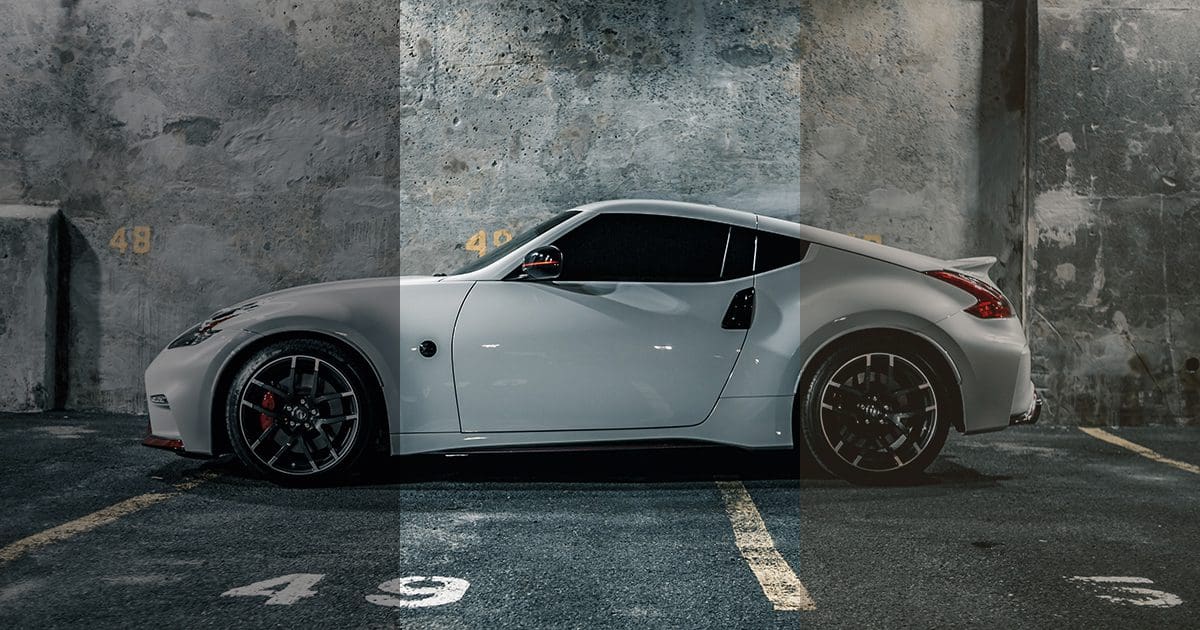 Picture this: You’ve just picked up a new car or truck from the dealer. They’ve washed it, given it a spritz with that lovely new car scent, put a big red bow on the hood or placed a basket of goodies in the trunk or cargo area. You’ve signed the papers, and you’re off for your first drive. For many of us, we’d drop by a family member’s or friend’s house to let them check out our new whip. For others, the first step is to start personalizing the vehicle. We’ve heard hundreds, if not thousands, of stories where new-vehicle owners head straight for their favorite automotive window tint shop for an upgrade. Unless you’re a veteran of vehicle upgrades, choosing the best window tint for your vehicle takes some knowledge and planning. What shade do you want? What safety and comfort options matter to you? Let’s look at automotive window tint shade and color considerations.
Picture this: You’ve just picked up a new car or truck from the dealer. They’ve washed it, given it a spritz with that lovely new car scent, put a big red bow on the hood or placed a basket of goodies in the trunk or cargo area. You’ve signed the papers, and you’re off for your first drive. For many of us, we’d drop by a family member’s or friend’s house to let them check out our new whip. For others, the first step is to start personalizing the vehicle. We’ve heard hundreds, if not thousands, of stories where new-vehicle owners head straight for their favorite automotive window tint shop for an upgrade. Unless you’re a veteran of vehicle upgrades, choosing the best window tint for your vehicle takes some knowledge and planning. What shade do you want? What safety and comfort options matter to you? Let’s look at automotive window tint shade and color considerations.
Why Should I Tint My Vehicle’s Windows?
There are four main reasons consumers might want the windows of their car or truck tinted. First, it can make the vehicle look better. A nice dark tint on a white or black vehicle can be very dramatic. The second reason people purchase window tint is comfort. The latest window tint films can block as much as 67% of the infrared heat energy from the sun. The third reason is security. Even a moderate tint film can help conceal objects left on the seat or floor of your vehicle. Finally and perhaps most importantly, all premium window films block between 97 and 99 of the harmful UV rays from the sun. This UV energy can damage your skin and accelerate the fading of leather, vinyl, carpets and upholstery in your vehicle. Your local mobile enhancement retailer can help you choose a film series to deliver the comfort and protection you want.
Understanding Window Tint Shades
Let’s start with a benchmark. The graph below is a spectrographic analysis of the energy coming from the sun. There was nothing in front of the sensor on the spectrometer.
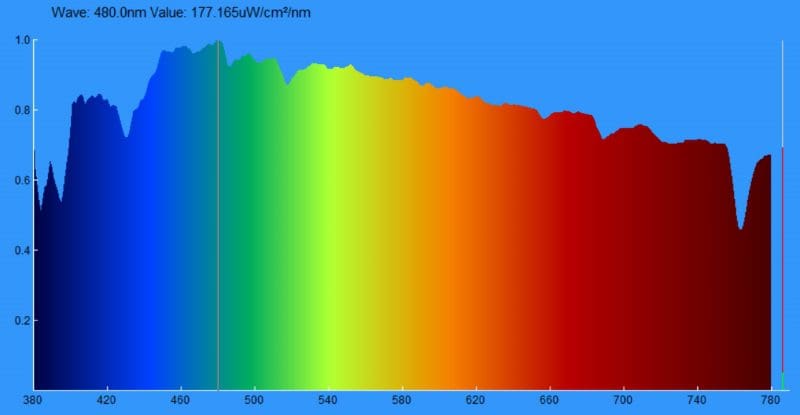
The horizontal axis on the graph represents the wavelength of light in nanometers. Wavelength is the inverse of frequency. We are approaching the ultraviolet range on the left side of the chart, where the color is purple or violet. On the far right, we have dark red and are approaching the infrared range. The vertical scale is intensity, measured in microwatts per square centimeter. A higher value on the Y-axis represents more light at that specific wavelength. The small red line in the graph highlights the wavelength that was the most intense (brightest) for that measurement. The brightest in this measurement was 480 nanometers, which is a blue-green color.
Before we start measuring the tint films, we need to measure a piece of glass. I called a few local glass shops, and Clegg Glass in Burlington, Ontario, was able to provide me with a 12-by-12-inch piece of 1/8-inch-thick glass in less time than it took me to drive to their facility. Have to love prompt service!
While easy to see through, you likely know that glass isn’t transparent – it’s close, though. Most glass has a light green shade that’s visible when you look at the edge. Clear glass like you’d find in a house window blocks a small amount of light – usually delivering a visible light transmission (VLT) of around 89%. If you thought we wouldn’t start this article by testing these, you haven’t read enough BestCarAudio.com articles!
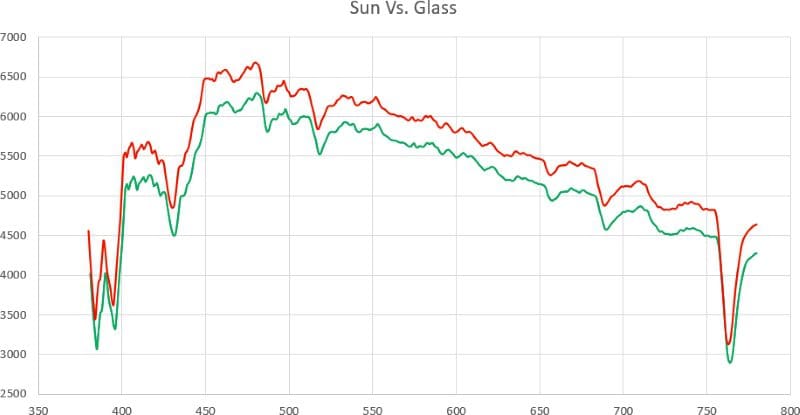
The chart above shows how much light energy passes through the glass compared with a direct reading from the sun. The difference isn’t significant.
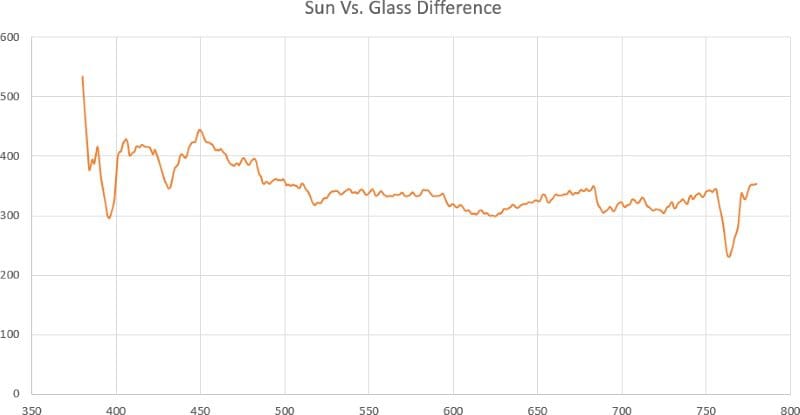
This third graph shows how much energy and at what wavelength the glass blocks. The glass transmits all wavelengths reasonably uniformly. We can see that it stops some blue energy at 450 nanometers more than other wavelengths. There’s a spike at 380 nanometers where it blocks more energy that’s approaching the ultraviolet range.
Testing Automotive Tint Film Light Transmission
We reached out to Mike at Mobile Edge in Lehighton, Pennsylvania, to get some samples of the 3M automotive window films. They kindly sent 2-by-2-inch squares of the 11 different films they had in stock at the time. We’ll start our explanation of the film shades by measuring the light transmission performance of the Ceramic IR series, as they sent samples of 70, 35, 25, 15 and 5%.
The graph shows how much light energy the spectrometer captured after passing through the different pieces of tint affixed to our glass piece. The Ceramic IR 70 with a 70% VLT is the top blue trace. Not surprisingly, the Ceramic IR 35 (yellow) lets in about half as much light energy as the CIR70. Of course, the CIR 5 is the darkest of the tints and lets in very little light energy.
A few interesting things to note from these measurements: All of the films do an excellent job of blocking low-wavelength energy in the violet range. This is because they are designed to offer excellent ultraviolet protection. 3M says they block over 99% of the UV energy from the sun. The second thing to notice is that the films have a downward taper to their transmission at higher wavelengths. Ceramic IR tint film offers good thermal energy rejection, so it makes sense that less infrared energy will pass.
Window Tint Shades
The next test is three different films with a 35% VLT rating. I had samples of Ceramic IR, Premium Series FX-HP and the Color Stable tint. Here’s how these films performed on our glass sample.
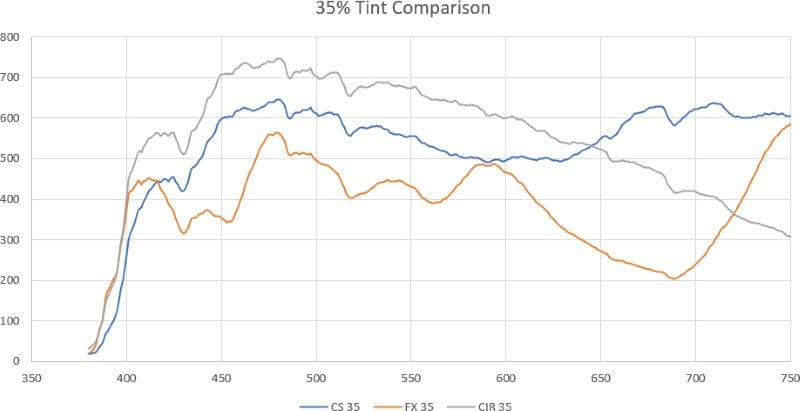
You’re likely to notice that FX-HP and Color Stable let through more energy in the higher wavelengths. These films are not marketed as being designed to block significant amounts of heat. Next, you’ll notice that FX-HP has a big dip around 690 nanometers (red) compared to the Color Stable film. The different balance of light energy transmission will not only make objects seen through the film look different but will give the film itself a different hue. Because the Ceramic IR films let more blue and green energy through, they have a slightly blue-green hue. Color Stable film has relatively neutral transmission characteristics, so it looks neutral and just grayish. Finally, FX Premium blocks more of the yellow and red wavelengths, so it has a very slight brown hue. As you can see by the dip on the left side of the graphs, all of the films do a great job of blocking UV energy.
Picking the Best Tint for Your Car or Truck
The product specialist at the mobile enhancement retailer installing the tint on your vehicle can help you navigate the options available to you. If you want heat rejection, Ceramic IR is the best choice. If you’re after a film that matches the tint on the factory privacy glass rear side windows, then Color Stable remains a popular option. If price is a concern, but you still want a quality film, then FX-HP is an excellent choice.
This article is written and produced by the team at www.BestCarAudio.com. Reproduction or use of any kind is prohibited without the express written permission of 1sixty8 media.
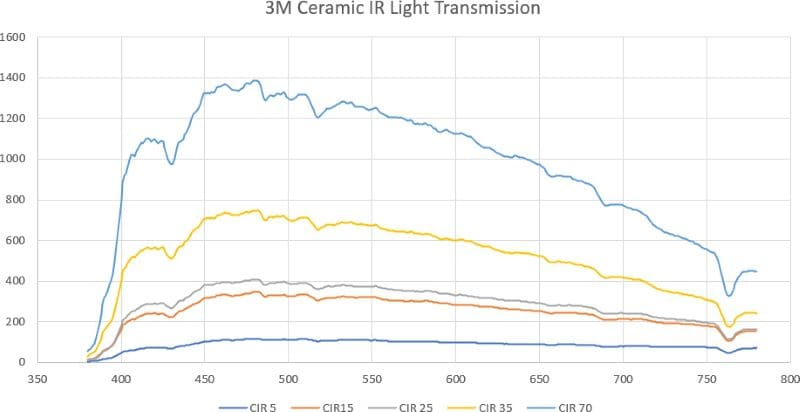
Leave a Reply